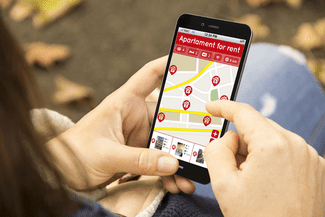Elevating the Resident Experience
Multifamily operators tap into technology to create efficiencies and better serve renters.

She’s young and needs an apartment.
She texts her friends instead of calling them. Her plans are made through online reservations. Her news comes from TikTok. There’s no way this Gen Y-er is phoning a leasing agent. She certainly doesn’t want to meet with one.
AvalonBay Communities has her back. Already, the company is using AI-powered virtual assistants to answer her questions. Virtual self-guided tours help keep personal interaction to a minimum. All move-in tasks can be handled via an app, including locker rentals for any extra items that need storing.
Before long, AvalonBay, which owns almost 80,000 apartment units, will introduce technology that will allow for self-service applications, renewals, and maintenance requests. Lauren can live comfortably for years without talking to anyone related to her accommodations.
And AvalonBay? It expects to enhance its net operating income by $10 million by embracing the technology that makes it all possible.
“Our operating model is set to deliver meaningful earnings growth by utilizing technology and investing in innovation to improve operating margins and unclog additional revenue opportunities,” an executive said in a recent earnings call.
Finding a Balance
Multifamily operators are adopting technology in their buildings at an unprecedented pace, partly because of the forced change brought on by the pandemic and partly because of the demographic shifts that have seen younger, tech-native renters demanding more from their landlords.
The question is no longer whether to implement technological solutions to what were once human problems, it’s how quickly to implement new and often cost-efficient systems without alienating those residents who still want face-to-face interactions.
The financial benefits are also substantial: Highland Ranch REIT said in a recent call with analysts that its new technology offerings that automated many processes allowed it to cut its headcount by 30% and increase customer satisfaction scores by 24%.
“I think the future just continues to be about self-service and how do we balance the cost of technology,” says Jackie Impellitier, vice president of operations at ZRS Management, which manages more than 50,000 units. “I think the conversation people don’t want to say out loud is that we’re all running companies … saying we’re looking to reduce [headcount] isn’t a popular thing to say. But ultimately, there needs to be some balance between adopting tech, solving problems, and making the process more efficient for the tenant.”
Startup Solutions
If one thing is clear in the multifamily industry, it’s that change is coming regardless of whether the big players are ready. Startups are changing the way people find and occupy apartments, and they are finding venture capital firms willing to back their endeavors.
Atlanta-based PadSplit has spent the past couple of years working with smaller landlords with their modern take on the rooming house. Its technology matches potential tenants to empty rooms in already-rented apartments, essentially acting as a matchmaking service for roommates. The innovation lies in the way it mitigates risk for the landlord—each tenant is on their own payment schedule for their portion of rent, making it less likely that an entire month’s rent would ever be missed.
 “We look at things like income and credit score,” says PadSplit CEO Atticus LeBlanc. “We create a payment process that can be quite complicated—if you have four people we could be collecting up to 20 payments a month if we are looking at weekly payments. For a housing provider, that would be a ton of work. We’re also building product and customer support around member disputes—so if John steals the peanut butter, there are options for dealing with that.”
“We look at things like income and credit score,” says PadSplit CEO Atticus LeBlanc. “We create a payment process that can be quite complicated—if you have four people we could be collecting up to 20 payments a month if we are looking at weekly payments. For a housing provider, that would be a ton of work. We’re also building product and customer support around member disputes—so if John steals the peanut butter, there are options for dealing with that.”
The company is looking to partner with larger multifamily owners, promising that delinquency rates will improve and overhead costs will decline as PadSplit takes care of identity verification and rental payments on behalf of the owners.
“We can get people into apartments who would never be able to,” LeBlanc says. “We’ve illustrated that you can expect a collection rate north of 97% even with low-income, low-credit renters in any type of unit. As we anticipate the next downcycle in the market, that’s quite an insurance policy for owners. Everyone is conscious of mitigating risk however they can.”
Innovative Ideas
That’s not to say the big players aren’t staking their claims. Morgan Properties—one of the country’s largest private owners of multifamily properties with 95,000 units—announced a deal earlier this year with venture capitalists Wilshire Lane Capital that will see it invest in technology companies it believes will help streamline its business processes and make things easier for residents.
“This wasn’t initially in our DNA, but in the last 10 years there’s been a tech focus as we think about how we can help site teams and operations,” says senior vice president of corporate strategy Amy Weissberger. “We’re interested in what’s coming that may not be developed yet, what startups are coming in the next iteration that can take property management to the next level.”
She leads an innovation team that brings in subject experts to look at “new technology that may not be fully discovered or developed yet” to see if it could fill a business need. While the pandemic helped accelerate tech adoption in many aspects of the business, particularly on the operational side, Morgan is also interested in bringing technological improvements into its buildings that enhance the resident experience.
“We’re looking at some interesting things like electric vehicle charging,” she says. “There’s one startup that has a unique software platform that doesn’t require connectivity to charge a car. Maybe that’s what’s next—but not everything we look at is something we’re going to invest in. We look at if it will improve our company, make us more efficient, and improve our net operating income. Our job is to say this does or does not work for us.”
Lincoln Property Co., which has 215,000 units under management, has also considered ways to bring more technology into its processes.
“We need to make the experience more consumer-grade and make it in line with the way we experience everything else that is not the multifamily industry,” says Khushbu Sikaria, vice president, Mid-Atlantic.
The company is running a program in Washington, D.C., where two new buildings are sharing amenities. The buildings are two blocks away—one has a rooftop pool, and one has a rooftop patio that offers better views. An app will allow residents of each building to share these spaces—with restrictions.
“You wouldn’t want to give someone access to the bike room in the other building,” she says. “But areas like co-working spaces and the pool, you could share these. You’d want to do it in off-peak hours so you don’t frustrate residents, so you’re not just giving full access. You really need to think strategically about how to activate that space.”
Understanding the Challenges
The challenge for any large operator—whether adopting back-end technology or new services targeted toward the resident’s satisfaction—is rolling out the technology at scale. With hundreds of thousands of units available to upgrade, it can be difficult to know which technologies to pursue.
“I’ve done a lot of due diligence into companies to understand what works, and we look at each product to understand redundancies and to make sure they integrate,” Sikaria says. “We do pilots and talk to team members to find out about their experiences. We need to know something adds value to the daily lives of residents and make sure there is high engagement with the technology. We don’t need to introduce more noise—that’s not helpful.”
There’s also the challenge presented by her diverse portfolio. Different classes of buildings can accommodate different upgrades, while some may not warrant any at all.
“There are only certain things worth doing at scale,” she says. “I manage a very diverse portfolio, and all individual buildings have their own needs. Depending on the age and overall financial status, each will have their own sets of technology and their own tech stock. But some things will be consistent—we want to make it very easy to schedule an appointment and do follow-ups.”
Again, startups are waiting on the sidelines looking to make things easier. Orro is a California-based company that uses technology to control lighting. It’s just moving into the multifamily space with technology that allows a building operator to control all smart technologies in a unit in one place, ensuring they don’t need to manually reset dozens of upgrades (think doorbells, thermostats, lighting units, speaker control) each time a tenant leaves.
“You need to think about what tenant turnover looks like,” says CEO Colin Billings. “When they leave, you need to reset and transfer all those credentials back to a new tenant. A property manager can use Orro to deregister that tenant and wipe that data and give control back to the landlord. That can be a 10-hour job if done manually. From where we’ve started, it’s an 80% reduction in operating expenses, it’s all about revenue preservation.”
Finding the Right Touch Point
While younger residents such as Lauren may love the independence that comes with the dehumanization of the rental experience, companies are also balancing the needs of those who would appreciate some tech upgrades in their unit but still want to deal with humans.
“We need to look at how people are operating in their personal lives,” Impellitier says. “We need to be able to provide the infrastructure so they can interact in their preferred method, so we can break into different generations. We need a fully automated digital way and also a hybrid way. Some like human to human, some don’t. The biggest thing we’ve taken away is that we can be digital, but we need to have different touch points for physical handoffs.”
Source: Multifamily Executive















 Accessibility
Accessibility